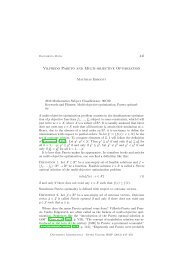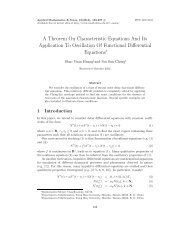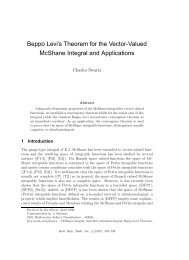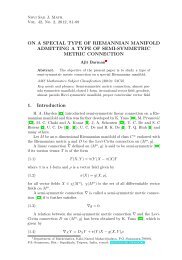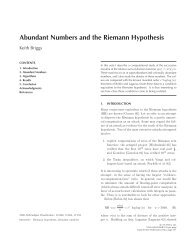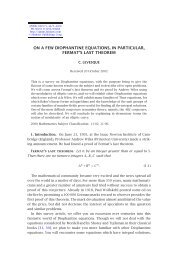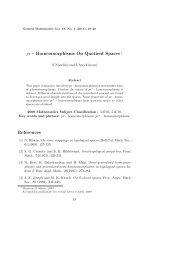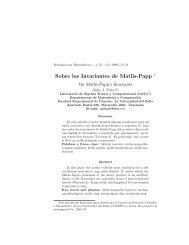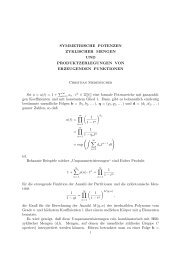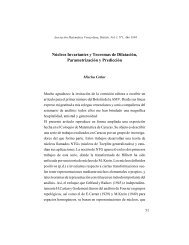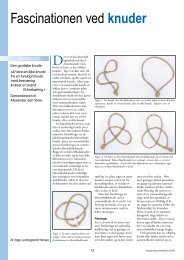A COMMON FIXED POINT THEOREM FOR MULTIVALUED´CIRI´C ...
A COMMON FIXED POINT THEOREM FOR MULTIVALUED´CIRI´C ...
A COMMON FIXED POINT THEOREM FOR MULTIVALUED´CIRI´C ...
Create successful ePaper yourself
Turn your PDF publications into a flip-book with our unique Google optimized e-Paper software.
An. S¸t. Univ. Ovidius Constant¸a Vol. 17(2), 2009, 19–26<br />
A <strong>COMMON</strong> <strong>FIXED</strong> <strong>POINT</strong> <strong>THEOREM</strong><br />
<strong>FOR</strong> MULTIVALUED ĆIRIĆ TYPE<br />
MAPPINGS WITH NEW TYPE<br />
COMPATIBILITY<br />
Ishak Altun<br />
Abstract<br />
Kaneko and Sessa defined the concept of compatibility for multivalued<br />
mappings with Hausdorff metric and proved a coincidence point<br />
theorem. After then, Pathak defined the concept of weak compatibility<br />
and proved a coincidence theorem. In the present work, we define a<br />
new type compatibility for multivalued mappings with Hausdorff metric.<br />
This new type compatibility is different from compatibility and weak<br />
compatibility. We give a common fixed point theorem for multivalued<br />
mappings using this new type compatibility.<br />
1 Introduction<br />
Throughout this paper, X stands for a metric space with the metric d whereas<br />
CB(X) denotes the family of all nonempty closed bounded subsets of X. Let<br />
H(A,B) = max{supd(x,B),<br />
supd(y,A)},<br />
x∈A y∈B<br />
where A,B ∈ CB(X) and d(x,A) = inf{d(x,y) : y ∈ A}. The function H is<br />
a metric on CB(X) and is called Hausdorff metric. It is well-known that, if<br />
X is a complete metric space, then so is the metric space (CB(X),H). Let<br />
Key Words: Fixed point, multivalued mapping, Hausdorff metric<br />
Mathematics Subject Classification: 54H25, 47H10<br />
Received: February, 2009; Revised: April, 2009<br />
Accepted: September 15, 2009<br />
19
20 Ishak Altun<br />
A,B ∈ CB(X) and k > 1. In the sequel the following well-known fact will be<br />
used [5]: For each a ∈ A, there is b ∈ B such that d(a,b) ≤ kH(A,B).<br />
Again B(X)stands for the set of all bounded subsets of X. The function δ<br />
of B(X)×B(X) into [0, ∞) is defined as δ(A,B) = sup{d(a,b) : a ∈ A,b ∈ B}<br />
for all A,B in B(X). If A = {a} is singleton, we write δ(A,B) = δ(a,B)<br />
and if B = {b}, then we put δ(A,B) = δ(a,b) = d(a,b). It is easily seen that<br />
δ(A,B) = δ(B,A) ≥ 0, δ(A,B) ≤ δ(A,C) + δ(C,B) and δ(A,B) = 0 implies<br />
A = B = {a} for all A,B,C in B(X).<br />
The concept of compatibility for single valued mappings, which is defined<br />
by Jungck , was extended for multivalued mappings by two ways as follows:<br />
Kaneko and Sessa extend it to include multivalued mappings with the metric<br />
H on CB(X) (Definition 2 in [4], see also Definition 3.2 in [2]). Jungck and<br />
Rhoades extend it to include multivalued mappings with the function δ in<br />
B(X) (Definition 3.1 in [2]). After then, this two definitions were weakened<br />
as follows: Pathak (Definition 4 in [6]) and Jungck and Rhoades (Definition<br />
2.2 in [3]) introduced the concept of weak compatibility with H and δ, respectively.<br />
It is well known that, compatible mappings are weakly compatible,<br />
but the converse is not true (see the related papers). Recently, the concept<br />
of compatible of type (I) mappings, which was introduced by Pathak et all.<br />
[7] for single valued mappings, has been extended to multivalued mappings<br />
with δ on B(X) by Altun and Turkoglu (Definition 2 in [1]). Also in [1], there<br />
are some mappings such that they are compatible of type (I) but not weakly<br />
compatible. The aim of this paper is to prove a common fixed point theorem<br />
for multivalued mappings using the metric H on CB(X). For this, we will<br />
introduce the definition of compatible of type (I) mappings for multivalued<br />
mappings with the metric H on CB(X).<br />
Definition 1 ([4]). The mappings f : X → X and S : X → CB(X) are<br />
compatible if fSx ∈ CB(X) for all x ∈ X and<br />
lim<br />
n→∞ H(Sfxn,fSxn) = 0,<br />
whenever {xn} is a sequence in X such that lim<br />
n→∞ Sxn = A ∈ CB(X) and<br />
lim<br />
n→∞ fxn = t ∈ A.<br />
Definition 2 ([6]). The mappings f : X → X and S : X → CB(X) are<br />
f-weak compatible if fSx ∈ CB(X) for all x ∈ X and the following limits<br />
exist and satify<br />
max{ lim<br />
n→∞ H(Sfxn,fSxn), lim<br />
n→∞ H(fSxn,fxn)} ≤ lim<br />
n→∞ H(Sfxn,Sxn),<br />
whenever {xn} is a sequence in X such that lim<br />
n→∞ Sxn = A ∈ CB(X) and<br />
lim<br />
n→∞ fxn = t ∈ A.
A <strong>COMMON</strong> <strong>FIXED</strong> <strong>POINT</strong> <strong>THEOREM</strong> <strong>FOR</strong> MULTIVALUED ĆIRIĆ TYPE<br />
MAPPINGS WITH NEW TYPE COMPATIBILITY 21<br />
Kaneko and Sessa [4] and Pathak [6] proved coincidence point theorems<br />
using the above definitions, respectively. Also, Turkoglu and Altun [8] proved<br />
a common fixed point theorem for multivalued mappings using two conditions<br />
instead of compatibility.<br />
Now, we introduce the following definition.<br />
Definition 3. The mappings f : X → X and S : X → CB(X) are compatible<br />
of type (I) if<br />
i) fSx ∈ CB(X), for all x ∈ X<br />
ii) d(t,ft) ≤ lim supH(A,Sfxn),<br />
whenever lim<br />
lim<br />
n→∞ fxn = t ∈ A.<br />
n→∞<br />
n→∞ Sxn = A ∈ CB(X) and<br />
The following example shows that f and S are compatible of type (I), but<br />
they are not f-weak compatible.<br />
Example 1. Let X = [0, ∞) be endowed with the Euclidean metric d. Let<br />
fx = 2x and Sx = {0} ∪ [1,2x + 2] for each x ∈ X. Let {xn} be a sequence in<br />
X such that<br />
lim<br />
n→∞ fxn = t, lim<br />
n→∞ Sxn = A ∈ CB(X),<br />
then t ∈ A if and only if t = 0 or t ≥ 1. Indeed, if fxn → t, then xn → t<br />
2 and<br />
so Sxn → A = {0} ∪ [1,t + 2].<br />
Now, if t ∈ A, then t ∈ {0} ∪ [1,t + 2], that is, t = 0 or t ≥ 1. On the<br />
contrary, if t = 0, then xn → 0 and so Sxn → {0} ∪ [1,2] = A. Thus t ∈ A.<br />
If t ≥ 1, then xn → t 1<br />
≥<br />
2 2 and so Sxn → {0} ∪ [1,t + 2] = A, that is, t ∈ A.<br />
Now, for t = 0, d(t,ft) ≤ lim supH(A,Sfxn)<br />
since d(t,ft) = 0. There-<br />
n→∞<br />
fore, f and S are compatible of type (I). On the other hand, for t = 0, we consider<br />
the sequence {xn} defined by xn = 1<br />
, then 0 �= lim<br />
n n→∞ H(Sfxn,fSxn) �<br />
lim<br />
n→∞ H(Sfxn,Sxn) = 0. Similarly, for t ≥ 1, we consider the sequence {xn}<br />
defined by xn = t 1<br />
+ , then 0 �= lim<br />
2 n n→∞ H(Sfxn,fSxn) � lim<br />
n→∞ H(Sfxn,Sxn) =<br />
0. This shows that f and S are not f-weak compatible as well as compatible.<br />
Proposition 1. Let f : X → X and S : X → CB(X) two mappings. If f and<br />
S are compatible of type (I) and fz ∈ Sz for some z ∈ X, then d(fz,ffz) ≤<br />
H(Sz,Sfz).<br />
Proof. Let {xn} be a sequence in X defined by xn = z for n = 1,2,3,... and<br />
fz ∈ Sz for some z ∈ X. Then we have fxn → fz and Sxn → Sz. Since f<br />
and S are compatible of type (I), we have<br />
d(fz,ffz) ≤ lim supH(Sz,Sfxn)<br />
= H(Sz,Sfz).<br />
n→∞
22 Ishak Altun<br />
2 Main result<br />
Now we give our main theorem.<br />
Theorem 1. Let (X,d) be a complete metric space. Let f,g : X → X and<br />
S,T : X → CB(X) be mappings such that f and S as well as g and T are<br />
compatible of type (I). Assume T(X) ⊆ f(X), S(X) ⊆ g(X) and, for all<br />
x,y ∈ X<br />
H(Sx,Ty) ≤ α max{d(fx,gy),[d(fx,Sx) + d(gy,Ty)]/2,<br />
[d(fx,Ty) + d(gy,Sx)]/2}, (2.1)<br />
where α ∈ (0,1). If f or g is continuous, then f,g,S and T have a common<br />
fixed point.<br />
Proof. Let x0 be an arbitrary point in X and let k > 1 so that αk < 1. We<br />
shall construct two sequences {xn} and {yn} of elements in X and a sequence<br />
{An} of elements in CB(X). Since S(X) ⊆ g(X), there exists x1 ∈ X such<br />
that y1 = gx1 ∈ Sx0. Then there exists an element y2 = fx2 ∈ Tx1 = A1,<br />
because T(X) ⊆ f(X), such that<br />
d(y1,y2) = d(gx1,fx2) ≤ kH(Sx0,Tx1).<br />
Since S(X) ⊆ g(X), we may choose x3 ∈ X such that y3 = gx3 ∈ Sx2 = A2<br />
and<br />
d(y2,y3) ≤ kH(Tx1,Sx2).<br />
By induction we produce the sequences {xn}, {yn} and {An} such that<br />
y2n+1 = gx2n+1 ∈ Sx2n = A2n, (2.2)<br />
y2n+2 = fx2n+2 ∈ Tx2n+1 = A2n+1, (2.3)<br />
d(y2n+1,y2n) ≤ kH(Sx2n,Tx2n−1), (2.4)<br />
d(y2n+1,y2n+2) ≤ kH(Sx2n,Tx2n+1) (2.5)<br />
for every n ∈ N. Letting x = x2n,y = x2n+1 in (2.1), we have successively<br />
H(Sx2n,Tx2n+1) ≤ α max{d(fx2n,gx2n+1),<br />
[d(fx2n,Sx2n) + d(gx2n+1,Tx2n+1)]/2,<br />
[d(fx2n,Tx2n+1) + d(gx2n+1,Sx2n)]/2}
A <strong>COMMON</strong> <strong>FIXED</strong> <strong>POINT</strong> <strong>THEOREM</strong> <strong>FOR</strong> MULTIVALUED ĆIRIĆ TYPE<br />
MAPPINGS WITH NEW TYPE COMPATIBILITY 23<br />
and so<br />
Thus<br />
H(Sx2n,Tx2n+1) = H(A2n,A2n+1)<br />
Similarly we obtain<br />
and so<br />
≤ α max{d(y2n,y2n+1),[d(y2n,A2n) +<br />
d(y2n+1,A2n+1)]/2,<br />
[d(y2n,A2n+1) + d(y2n+1,A2n)]/2}<br />
≤ α max{d(y2n,y2n+1),[d(y2n,y2n+1) +<br />
d(y2n+1,y2n+2)]/2,<br />
[d(y2n,y2n+2) + 0]/2}<br />
≤ α max{d(y2n,y2n+1),[d(y2n,y2n+1) +<br />
d(y2n+1,y2n+2)]/2}. (2.6)<br />
d(y2n+1,y2n+2) ≤ kαd(y2n,y2n+1). (2.7)<br />
H(Sx2n,Tx2n−1) = H(A2n,A2n−1) ≤ αd(y2n−1,y2n) (2.8)<br />
d(y2n,y2n+1) ≤ kαd(y2n−1,y2n). (2.9)<br />
Since kα < 1 it follows from (2.7), (2.9) that {yn} is a Cauchy sequence. Hence<br />
there exists z ∈ X such that yn → z. Therefore, gx2n+1 → z and fx2n → z.<br />
Also from (2.6) and (2.8) and the fact that {yn} is Cauchy sequence it follows<br />
that {Ak} is Cauchy sequence in the complete metric space (CB(X),H). Thus<br />
Ak → A ∈ CB(X). This implies Tx2n+1 → A and Sx2n → A and therefore<br />
z ∈ A, because<br />
d(z,A) = lim<br />
n→∞ d(yn,A) ≤ lim<br />
n→∞ H(An−1,An) = 0.<br />
Now suppose that g is continuous. Since g and T are compatible of type<br />
(I), we have<br />
d(z,gz) ≤ lim supH(A,Tgx2n+1)<br />
(2.10)<br />
n→∞<br />
and ggx2n+1 → gz. Setting x = x2n and y = gx2n+1 in (2.1), we have<br />
H(Sx2n,Tgx2n+1) ≤ α max{d(fx2n,ggx2n+1),<br />
[d(fx2n,Sx2n) + d(ggx2n+1,Tgx2n+1)]/2,<br />
[d(fx2n,Tgx2n+1) + d(ggx2n+1,Sx2n)]/2},
24 Ishak Altun<br />
taking limit superior we have<br />
lim supH(A,Tgx2n+1)<br />
n→∞<br />
≤ α max{d(z,gz),[d(z,A) +<br />
lim supd(gz,Tgx2n+1)]/2,<br />
n→∞<br />
[lim supd(z,Tgx2n+1)<br />
+ d(gz,A)]/2},<br />
n→∞<br />
≤ α max{d(z,gz),[0 + d(gz,z) +<br />
lim supd(z,Tgx2n+1)]/2,<br />
n→∞<br />
[lim supd(z,Tgx2n+1)<br />
+ d(gz,z)]/2},<br />
n→∞<br />
≤ α max{d(z,gz),[d(gz,z) +<br />
lim supH(A,Tgx2n+1)]/2,<br />
n→∞<br />
[lim supH(A,Tgx2n+1)<br />
+<br />
n→∞<br />
d(gz,z)]/2}, (2.11)<br />
From (2.10) and (2.11) we have d(z,gz) = 0 and so z = gz.<br />
Again setting x = x2n and y = z in (2.1) we have<br />
H(Sx2n,Tz) ≤ α max{d(fx2n,gz),[d(fx2n,Sx2n) + d(gz,Tz)]/2,<br />
[d(fx2n,Tz) + d(gz,Sx2n)]/2},<br />
= α max{d(fx2n,z),[d(fx2n,Sx2n) + d(z,Tz)]/2,<br />
[d(fx2n,Tz) + d(z,Sx2n)]/2},<br />
and allowing n → ∞ we have H(A,Tz) = 0 and so Tz = A. Since z ∈ A, then<br />
z ∈ Tz.<br />
Now since T(X) ⊆ f(X) there exists a point w ∈ X such that fw = z ∈ Tz.<br />
Now setting x = w and y = z in (2.1) we have<br />
that is<br />
H(Sw,Tz) ≤ α max{d(fw,gz),[d(fw,Sw) + d(gz,Tz)]/2,<br />
[d(fw,Tz) + d(gz,Sw)]/2}<br />
H(Sw,A) = 0.<br />
This shows that fw = z ∈ Sw = Tz = A. Since f and S are compatible<br />
of type (I) and fw ∈ Sw, then using Preposition 1, we have d(fw,ffw) ≤<br />
H(Sw,Sfw) and so<br />
d(z,fz) ≤ H(A,Sz). (2.12)
A <strong>COMMON</strong> <strong>FIXED</strong> <strong>POINT</strong> <strong>THEOREM</strong> <strong>FOR</strong> MULTIVALUED ĆIRIĆ TYPE<br />
MAPPINGS WITH NEW TYPE COMPATIBILITY 25<br />
Again setting x = z = y in (2.1), we have<br />
that is<br />
H(Sz,Tz) ≤ α max{d(fz,gz),[d(fz,Sz) + d(gz,Tz)]/2,<br />
[d(fz,Tz) + d(gz,Sz)]/2}<br />
H(Sz,A) ≤ αd(fz,z). (2.13)<br />
From (2.12) and (2.13), we have d(z,fz) = 0 that is z = fz = gz ∈ A = Tz =<br />
Sz.<br />
The other case, f is continuous, can be disposed of following a similar<br />
argument as above.<br />
We have the following corollary of the Theorem 1, which is the multivalued<br />
version of Corollary 3.1 of [7].<br />
Corollary 1. Let (X,d) be a complete metric space. Let f,g : X → X<br />
and S,T : X → CB(X) be mappings such that f and S as well as g and T<br />
are compatible of type (I). Assume T(X) ⊆ f(X), S(X) ⊆ g(X) and for all<br />
x,y ∈ X<br />
H(Sx,Ty) ≤ αd(fx,gy)<br />
where α ∈ (0,1). If f or g is continuous, then f,g,S and T have a common<br />
fixed point.<br />
Acknowledgement: The author is thankful to the referees for their valuable<br />
comments in modifying the first version of this paper.<br />
References<br />
[1] I. Altun and D. Turkoglu, Some fixed point theorems for weakly compatible<br />
multivalued mappings satisfying an implicit relation, Filomat, 22 (1)<br />
(2008), 13-23.<br />
[2] G. Jungck and B. E. Rhoades, Some fixed point theorems for compatible<br />
maps, Internat. J. Math. Math. Sci., 16 (3) (1993), 417-428.<br />
[3] G. Jungck and B. E. Rhoades, Fixed points for set valued functions without<br />
continuity, Indian J. Pure Appl. Math., 29 (3) (1998), 227–238.<br />
[4] H. Kaneko and S. Sessa, Fixed point theorems for compatible multivalued<br />
and single-valued mappings, Internat. J. Math. Math. Sci., 12 (1989), 257-<br />
262.
26 Ishak Altun<br />
[5] S. B. Nadler, Multivalued contraction mappings, Pacific J. Math., 20 (2)<br />
(1969), 457-488.<br />
[6] H. K. Pathak, Fixed point theorems for weak compatible multi-valued ans<br />
single-valued mappings, Acta Math. Hungar., 67 (1-2) (1995), 69-78.<br />
[7] H. K. Pathak, S. N. Mishra and A. K. Kalinde, Common fixed point<br />
theorems with applications to nonlinear integral equations, Demonstratio<br />
Math., 32 (3) (1999), 547–564.<br />
[8] D. Turkoglu and I. Altun, Fixed point theorem for multivalued mappings<br />
satisfying an implicit relation, Tamkang J. Math., 39 (3) (2008), 247-253.<br />
Kirikkale University<br />
Faculty of Science and Arts<br />
Department of Mathematics<br />
71450 Yahsihan, Kirikkale, Turkey<br />
Email: ialtun@kku.edu.tr, ishakaltun@yahoo.com



